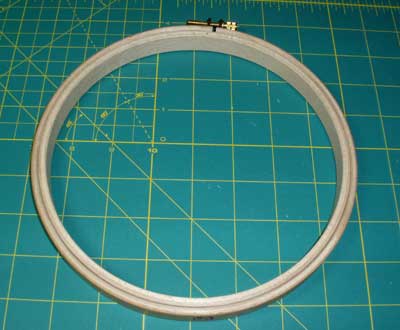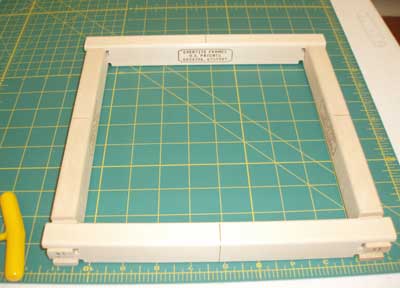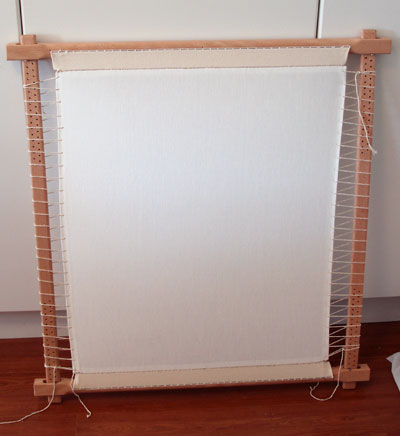Embroidery Hoop vs. Embroidery Frame

A hoop is a set of two rings – either wood or plastic (sometimes metal, but metal is never the best option) – each ring fitting inside each other, holding the fabric taut while you stitch. The hoop usually has some hardware on it (a bolt for tightening) and is usually held in the hand.
A frame is made of wood, and the embroidery fabric is stretched
taut and pinned, tacked, or sewn in some way onto the frame. Frames
are normally held on some kind of stand or propped on the edge of
the table during stitching, unless they are small and light. There
are several types of embroidery frames.
Types of Embroidery Frames
There are different types of embroidery frames: stretcher bar frames, slate frames, and scroll frames.

Stretcher bar frames are generally fixed size frames sold in pairs. Two pairs make a full frame. They lock together with “dove tail” teeth on the corners, and then the fabric is tacked onto the resulting frame, using thumbtacks.

Slate frames (pictured above) are made of two types of bars: side bars (or slats) that fit into roller bars (top and bottom of the frame). The slats have holes in them and allow you to adjust the up and down tension on the fabric, which is sewn onto the roller bars. The sides of the fabric are laced onto the side slats, so that you can tighten the lacing and therefore tighten the side to side tension on the fabric.
Scroll frames are somewhat like slate frames, but they don’t
allow for the top-to-bottom stretch that a slate frame allows, and
the fabric isn’t usually laced on the sides.
Uses for Embroidery Frames and Hoops
The embroidery hoop can be used for small and large surface embroidery projects. On small projects, it’s best if the hoop encircles the whole project design area. On large projects (such as table cloths and the like) worked in surface embroidery, the hoop is moved from place to place on the project.
Often, to maintain maximum tautness and to minimize the risk of damaging embroidery and soiling fabric, an embroidery hoop is bound with twill tape and a protective layer of fabric, tissue paper, or even plastic wrap is mounted in the hoop over the embroidery ground fabric.
Stretcher bar frames can only be used on projects that fit within the entire “frame” area of the stretcher bars. Why? Because the fabric is tacked onto the frame, and the holes made by the tacks mar the fabric. The tacks only go on the very edge, or waste area of the embroidery fabric.
Slate frames can accommodate very large projects, as long
as they fit the width of the roller bars. Any excess fabric,
lengthwise, is rolled onto the roller bars as the project
progresses.
Advantages and Disadvantages of Hoops and Frames
Embroidery Hoops
Advantages: 1. it can be help relatively comfortably in the hand; 2. it can be moved around on very large surface embroidery projects; 3. it is relatively inexpensive, even when purchasing a good hoop (when compared to some of the other frame options).
Disadvantages: 1. ring marks, which can be removed from washable embroidery projects, but not from embroidery projects that can’t be washed (like goldwork or many types of silk embroidery or embroidery worked on fabrics like silk and velvet); 2. hoops can be uncomfortable to hold, especially for stitchers with arthritis; 3. hoops (especially poorly made hoops) can damage fabric; 4. hoops (especially poorly made hoops) do not always provide maximum tautness on the fabric.
Stretcher Bar Embroidery Frames
Advantages: 1. they maintains good tension; 2. they can be accommodated on many floor and table stands, which allows both hands to be free while stitching; 3. they are relatively inexpensive.
Disadvantage: once the fabric is mounted on the frame and tacked all around, it cannot be re-tensioned without removing tacks, re-stretching the fabric, and replacing the tacks. The exception to this is the Evertite stretcher bar frame, which allows for some tensioning even after the fabric is tacked all around on the frame.
Slate Frames
Advantages: 1. they can accommodate large pieces (or small); 2. they easily maintain the best tension on embroidery ground fabrics; 3. they leave both hands free for two-handed stitching.
Disadvantages: 1. they are not widely available; 2. when they are available, they are expensive; 3. they can be large and bulky, so they normally require trestles to support them; 4. they take a long time to set up or “dress”, more so than any other hoop / frame option.
Scroll Frames
Advantages: 1. They are fairly widely available; 2. They are relatively easy to set up; 3. They can accommodate a range of different sized projects, as long as the project fits within the width of the roller bars.
Disadvantages: 1. Without lacing, they rarely maintain good tension from side-to-side all across the fabric; 2. They’re not usually made to accommodate lacing, as they have hardware in the middle of the side bars which can get in the way of lacing; 3. The rollers have a fixed location in relation to the side bars, so they are not adjustable from top to bottom. The top-to-bottom tension is maintained by how tightly the fabric is rolled, rather than by being able to easily move the rollers up and down on the side bars (like you can with a slate frame).